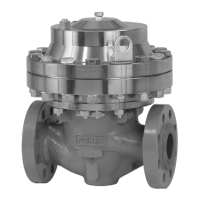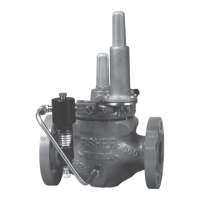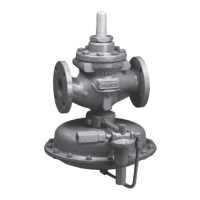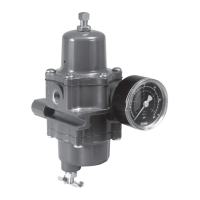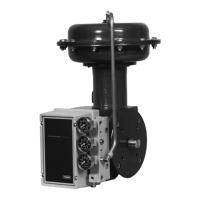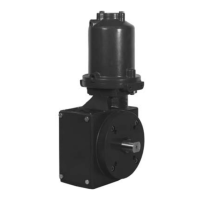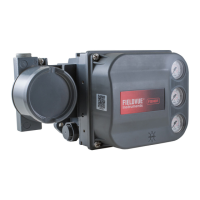Type EZR
12
maximum performance by decreasing the restrictor
setting for tighter control (increased opening speed,
decreased closing speed); or increasing the restrictor
setting for maximum stability (decreased opening speed,
increased closing speed). A lower setting also provides
a narrower proportional band for better accuracy. The
“8” position has the largest ow, is most stable, and
easiest for startup, however, using the “8” position
is not necessary. The “0” setting has the smallest
(minimum) ow passage; at no point of rotation will the
Type 112 restrictor be completely shut off. After initial
adjustment, the restrictor does not need to be adjusted
for maintenance or startup.
For stable, low ow operation, other considerations
besides pilot settings should also be addressed.
Installation of an oversized regulator may make low ow
operation difcult. When possible, a smaller-sized
Type EZR should be installed. During design of a
regulator installation, the downstream piping volume
should be maximized. Control lines should not be located
in or near piping sections that may experience turbulent
ow, such as elbows or swages. Larger diameter control
lines are also recommended in low ow conditions. The
larger control lines are less restrictive and will reduce pilot
exhaust bleed backpressure to the pilot that may cause
instability. Separate sense and exhaust lines may also
help at low ow conditions. This feature is provided on
the PRX Series, Types 161M, 161HM, 161EBM, and
161AYM pilots. Control line taps should be located in
straight pipe; several pipeline diameters (8 to 10 of largest
piping on outlet) downstream of the regulator. These
guidelines are not mandatory but have been used to
improve station stability at low ow in some systems.
!
WARnInG
1. If the pilot setting must be disturbed, be sure to
keep some tension on the spring. This will prevent
trapping inlet pressure during blow down.
2. Close the valves shown in Figure 3 or 4, in the
following order:
a. Inlet block valve
b. Outlet block valve
c. Control line valve(s), if used
3. Open the vent valves to depressurize the system.
PILOT
TYPE
TYPE 112
RESTRIcTOR
SETTInGS FOR
LOW FLOW
OPERATIOn
ORIFIcE SIZE(S)
FOR LOW FLOW
OPERATIOn
TYPE 112
RESTRIcTOR
ORIFIcE SIZES TO
OPERATIOn
161AY
Series
Pilots
Restrictor Setting
of “5” or greater
3/32 or 1/8-inch
(2,38 or 3,18 mm)
(3/32-inch (2,38 mm)
is standard)
Restrictor Setting
of “2” or less if
continuous ows are
expected to be less
than 5% of
maximum capacity
Note: Higher Type 112 restrictor settings will increase proportional band. Adjustment of
the Type 112 restrictor will also cause a shift in setpoint. Setpoint should be checked
and adjusted following restrictor setting adjustment.
Table 6. Type 161AY/161AYM Pilot
Adjustment Recommendations
Table 7. Type PRX Pilot Adjustment Recommendations
PILOT
TYPE
TYPE PRx RESTRIcTOR
SETTInGS FOR LOW
FLOW OPERATIOn
TYPE PRx
SETTInGS TO
OPERATIOn
PRX/120 and
PRX/120-AP Series
- 1 turn out
(counterclockwise) from
fully seated for most
low ows
- 2-1/2 turns out (for ows
less than 5% of maximum)
- Fully out
(counterclockwise) from
seated for most low ows
- One turn out (for ows
less than 5% of maximum)
– Fully seated
(clockwise) or full out
(counterclockwise)
– Full in (clockwise)
Note: Counterclockwise adjustment of the Type PRX restrictor screw will increase
proportional band. Adjustment of the restrictor screw will also cause a shift in setpoint.
Setpoint should be checked and adjusted following restrictor screw adjustment.
Table 5. 161 and 161EB Series Pilot
Adjustment Recommendations
PILOT
TYPE
TYPE 112 RESTRIcTOR
SETTInGS FOR LOW
FLOW OPERATIOn
TYPE 112 RESTRIcTOR
FLOW OPERATIOn
161/161H
Series Pilots
Restrictor Setting of “5”
or greater
Restrictor Setting of “2” or
less if continuous ows are
expected to be less than 5% of
maximum capacity
161EB
Series Pilots
Restrictor Setting of “5”
or greater
Restrictor Setting of “2” or
less if continuous ows are
expected to be less than 5% of
maximum capacity
Note: Higher Type 112 restrictor settings will increase proportional band. Adjustment of
the Type 112 restrictor will also cause a shift in setpoint. Setpoint should be checked
and adjusted following restrictor setting adjustment.
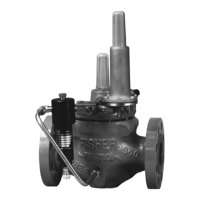
